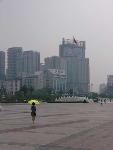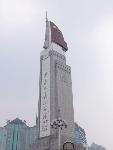- Getting around Lijiang. Dont stay in the Old Towns more than 2 days, there is nothing to do. KRISS Oct 9, 2013 05:46
- 2013 Beijing Temple Fair BENNYLAU Feb 26, 2013 03:29
- Malaysian traveling from KUL - LAX vis Shanghai PVG ZATI_DY Jan 3, 2013 20:15
On the First of August
- Views: 5974
- |Vote: 0 0
- |Add to Favorites
- |Recommend to Friends
The People Rise
There was one significant reason why I was interested in visiting the city of Nanchang other than seeing the sights and trying the local cuisine - for Nanchang is remembered in Chinese history as the birthplace of the People's Liberation Army, and is the location of the first significant military action that began the Chinese Communist forces' long struggle to the leadership some twenty years later. In recent weeks I've been reading the illuminating 'Red Star over China' by Edgar Snow, the first Western journalist who had the opportunity to interview Chairman Mao and his compatriots in the CCP when they were holed up in northern Shaanxi Province and building up their strength - and I was finding his intimate portrayals of the men who would change the political face of China forever to be absolutely compelling. The chance to see something of the place where the armed forces of the People's Liberation outfit made their first move was therefore something I personally found to be of great interest.
Not many people outside of China are aware that before the Nationalist and Communist parties began their struggle against each other, they were close allies. In the early twentieth century, the Communists were in alliance with the Goumindang national party and it was in Nanchang that heroic Communist leaders Zhu De and Zhou Enlai (who would later become Premier over all China itself) had been stationed with their armies by the Nationalist party of whom they were members. It all went sour in 1927 when Chiang Kaishek announced that the Communists were the enemies of the party and would be expelled, something which probably came as a surprise to the Communists at the time, who were prepared to support the Nationalists to stabilise the country and resist the Japanese imperialists as far as was necessary. Zhu De and Zhou Enlai decided to make their move, and on the first of August in 1927, successfully led their armies to capture Nanchang and put the city under communist leadership. It was a greatly encouraging move for the soldiers, but before too long they were forced into retreat and went on to make a number of manouevers of varying success - but the army had been created by the uprising on August the First, and even now the Chinese characters for '8' and '1' can be seen on the PLA flags all over the country.
Nanchang maintains a reputation today as a revolutionary city, and the layout and architecture of Nanchang often reflects this. Older buildings in the city are strictly utilitarian in keeping with Spartan policies of previous decades, and pride of place is given to memorials and displays relating to the August 1st uprising. The date is commemorated in many a placename and on many a road sign, and so I was determined to do a survey of these places and explore Nanchang's revolutionary history as it is remembered by monuments and parks across the city.
Bayi Square
The obvious place to begin is Bayi Square, the unofficial centre of town, and the focus of the areas which commemorate the revolution. The square is an easy bus ride away from the train station on route 2, and I quickly located the busses which leave every few minutes from the station square. The ride isn't long, but in the heat of Nanchang's unforgiving sun it's not the most pleasant of excursions - I noticed not only myself but all of the passengers of the bus were wet with perspiration. The crowds that slid past my bus window glass seemed frustrated to even be outside in weather like this, and I saw many people bickering hotly at the slightest of provocations. More touchingly, I saw a young woman with a handkerchief patiently wipe the sweat off her boyfriend's dark, thick muscles, who stood exhausted in his singlet, hanging from the passenger straps.
Bayi Square appears, in layout at least, a little like the northern half of Beijing's Tiananmen. There is the mighty flagpole, with the red flag flying high at the top, and at the southern end of the square is an enormous monument to the fallen in the struggle for freedom - a thick column, with a sculpture on top itself shaped like a flying red national flag.
The square sits centrally on Great Bayi Road (Bayi Dadao) and is surrounded by mostly modern commercial buildings and housing developments. Standing rather imposingly opposite the western side of the square is the Jiangxi Provincial Exhibition Centre, ostentatiously overdecorated in soviet motifs and with a great shining central red star - I went across to check it out, but was rather surprised that it no longer holds exhibitions at all but rather is home to an electronics and computer market - the likes of which are scattered all across Nanchang. I walked inside not so much to inspect the building as to enjoy the frigid air-conditioned atmosphere, and saw nothing of the decorousness of the exterior inside - just wide halls, merchants calling for customers' attention, peddling laptops and TV screens and MP3 players.
To the north of the square too is another air-conditioned foreigner's haven - a Walmart complex with a KFC, where anyone visiting the city and craving imported items, or just safe, fresh produce can stock up on these and then feast on a chicken burger.
However, I was looking for more austere, political monuments and moved on. About 10 minute's walk north of the square is another revolutionary monument that commemorates martyrs of the uprising - worth a wander past as you veer off to the left on your way to Bayi Park. The walk is a refreshing way to gain an impression of modern Nanchang - this is really the centre of town, and a good place to be familiar with whether you're just passing through or are planning on staying a while longer. In the hot weather, though, walking anywhere is a big ask, and I hurried my way along to Bayi Park, where I knew I could at least sit in a little pagoda and fan myself in the shade.
Bayi Park
It's hard to say why, but Nanchang's Bayi Park made a big impression on me. Maybe it's the fact that despite my enthusiasm, I'd not yet found terribly much to like about Nanchang. I'd enjoyed visiting the famous Tengwang Ge, but little else about the city seemed to hold any appeal - it's a grey, squalid place made only worse by the fact that it's the provincial capital, and thus a busy thoroughfare. The political memorials are important, but very simple, and even the new modern skyrises have the look of experiments in more smoggy shades of grey.
But the park is something far more elegant - with old homes lined up against the reserve, reflected in the water of the lake, this was something worth taking pictures of and coming to see. Despite the name, I found nothing about the park remembered the famous events of the August Uprising, but even thus it was a fitting representation of the kind of liberty that the protagonists of that war were trying to win and protect. Despite what is said overseas about the Chinese Government, no previous administration brought so much peace and prosperity to the ordinary Chinese people.
The park is free to enter, and embellished with the kind of delicate set pieces typical to all good Chinese parks - little pagodas, walkways, humped marble bridges and cascades of willow sweeping down into the water. The park is set around a central lake, in the middle of which is an island covered in shady trees and - unusually - a reptile house, with a ten yuan entry fee and an impressive display of rare snakes.
Beyond the park lies what appears to be one of Nanchang's hot entertainment spots. A couple of large karaoke halls stood next to expensive coffee houses and bars - a good place to come for a night on the town for those travellers with a little extra cash. However, given that i was on something of a less frivolous itinerary for the day, it was time to head for the last stop - the August 1 Uprising Museum.
It was a short taxi ride to the museum on Zhongshan Lu - taxis in Nanchang start at RMB6 and the final fare is rounded to the nearest yuan - built into an old hotel. The museum is an odd looking place that was once the very site where the communists met and made their plans - it was in this very hall that the uprising I'd come to investigate was conceived and worked out. It is a bleak, functional museum, but one that successfully conveys the stark desperation of the times, and the gritty determinism of the communists to come out on top - which they eventually did, of course.
My overall impression of Nanchang's revolutionary memorials and displays was mixed - but perhaps they are designed to be somberly impressive, demonstrative of the hard-line serious intent of this period in China's history - and in that sense, these shows of respect certainly serve their purpose. But I like to think that Zhu De and Zhou Enlai were more visionary men than these solid tributes tend to reveal. The ideals they fought for were something noble and desperately patriotic - and I somehow wished that the designers of these monuments had been a little more exuberant in their gratitude to these great men and the endeavours of their armies.






 Copyright © 1998-2025 All rights reserved.
Copyright © 1998-2025 All rights reserved.